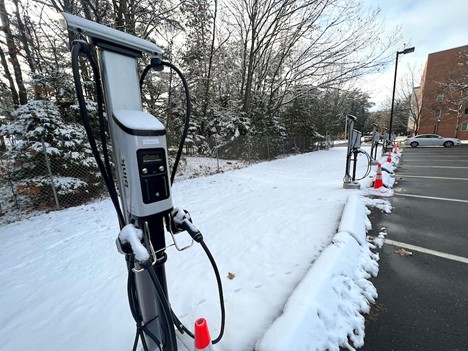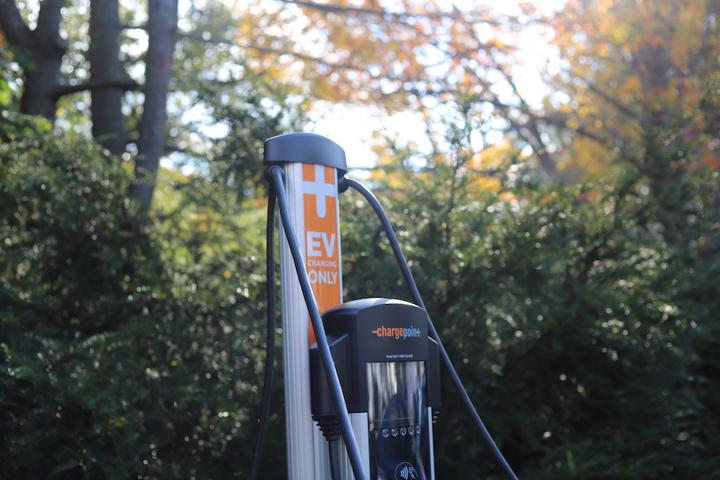
By Rebecca Goldfine
Bowdoin recently sold its high-value, Maine-based renewable energy credits (RECs) to free up funds to buy RECs in so-called "dirtier" electrical grids and to invest in green projects and technologies that will help reduce Bowdoin’s greenhouse gasses.
With some of its new funding, Bowdoin's Office of Sustainability added twelve new chargers to the Coffin Street parking lot.
By supporting renewable energy projects in grids dominated by fossil fuels, Bowdoin can help accelerate their transition to greener energy sources. Additionally, the move gives the College an additional $500,000 to invest in electric vehicles (EVs) and EV chargers, as well as in other battery-operated equipment.
The College just added twelve new chargers to the Coffin Street parking lot, as well as purchased a new electric sedan that faculty, staff, and students can sign out for work or school trips. Soon, it will also add a new all-electric Ford van for facilities crews. (The Coffin Street chargers will be ready to use after the holiday break.)
REC Arbitrage
The move to sell the RECs came after years of heavily supporting Maine-based solar energy, which Bowdoin continues to do. Since 2014, the College has helped finance start-up solar projects around the state by committing to purchase their electricity for many years or by buying the associated RECs. In most cases, it has done both.
RECs are market-based, tradable assets that reflect the environmental benefits of the new energy. They give buyers tangible ownership rights to the intangible megawatts generated by sun, wind, or water that get mixed in with the power flowing through the electricity grid.
Last spring, the College's sustainability implementation committee decided to sell Bowdoin's Maine-based solar RECs—which have considerable value in the REC compliance market—to buy less expensive credits from renewable energy projects in parts of the country that are more dependent on oil, gas, or coal.

EV charger in the Roux Center for the Environment parking lot.
Because of the difference in price between the Maine solar RECs that Bowdoin sold and the Midwestern RECs it purchased from wind farms, the College now has an additional half million dollars.
Keisha Payson, director of sustainability, says the money will be used to continue electrifying Bowdoin's fleet of cars, install additional charging stations in campus parking lots, and replace other gas-using equipment with battery-powered ones.
"It is a smart and prudent thing to do as a way to speed up our path to becoming fossil-fuel free," Payson said. "We are using our resources wisely."
For an institution like Bowdoin that is committed to addressing the climate crisis, selling Maine-based RECs to buy less expensive ones elsewhere is sensible, said Matt Gamache ’13, vice president of Competitive Energy Services, a Portland-based company that advises the College.
"When you replace these with cheaper, or lower-value ones, you can still claim the use of the renewable energy being generated," he explained, "while you are buying from parts of the country where the average carbon-per-kilowatt hour on grids is much higher."

Signs indicate a bicycle route and the EV charging stations near the Roux Center for the Environment.
Purchasing RECs from regions where fossil fuels still dominate the energy market indicates demand and helps spur more investment in green infrastructure. "Buying into dirty grids supports green energy projects where there may not be the political mandate to do so like we have here in Maine with our renewable portfolio standards, requiring dirty electricity generators in Maine to buy RECs that offset a portion of their emissions," Payson said.
Maine-based RECs are pricier than others around the country because the state has created what is known as a "compliance market" by requiring a certain percentage of electricity that is supplied here be derived from a renewable source, explained Gamache. In 2024, this amount is 55 percent, and the "percentage increases each year until it hits 80 percent in 2030 and stays flat after that," he added.
This means that multinational corporations like Constellation Energy, Direct Energy, Shell Energy, and BP all must procure Maine RECs to comply with the law and do business in the state, thereby pushing prices up.
Other energy markets operating in states that don't have a comparable policy are considered to have voluntary markets. "Anyone buying RECs in Iowa, for instance, is doing it voluntarily. No one is telling you to do it," Gamache said.
The difference leads to a price variation where a Maine REC is currently five to ten times more expensive than one sold in a voluntary market.
A Solar Foundation

Solar array at Brunswick Landing, site of the former Navy base.
About a decade ago, Bowdoin started to get serious about solar. Its first significant step toward transitioning to renewable power sources was to develop a solar array at the former Brunswick Naval Station close to campus, as well as install solar panels on several campus buildings.
In 2018, the College joined four other liberal arts colleges—Amherst, Hampshire, Smith, and Williams—to help fund NextEra Energy’s construction of a 76.5-megawatt solar project in Farmington, Maine. Bowdoin's shares of these RECs offset nearly half of the College’s annual electricity consumption.
In 2021, Bowdoin joined a consortium with more than twenty businesses and organizations to contract about 1,400 MWhs per year—about seven percent of the College's current electricity consumption—from new hydro and solar projects around the state.
A year later, the College expanded its solar array at the former Navy base, adding 17,000 panels to the 4,420 it had set up earlier, enough to meet approximately 45 percent of its annual electrical energy consumption.
These initial investments got solar projects up and running, helping Maine move closer to its goal of achieving 80 percent clean energy by 2030 and 100 percent by 2050.
Meanwhile, the value of the RECs Bowdoin held began to increase. "Once we saw how much money the RECs were generating and knew what we could potentially do with that money, we started to seriously consider selling them," said Payson. The College can revisit the decision to sell the RECs at any time, as the RECs accrue each quarter of the twenty-year energy contracts.
"When the College made those commitments to buying the RECs, it enabled the projects to exist," Gamache said. "Now you are selling that claim, which allows the College to make back some of the costs it paid to those projects."
"It is almost like doubling down on the benefit of the project," he continued, "because you have brought a new renewable project online, and by selling the RECs you are able to use that money to further green your campus."
Photos: Courtesy of Bowdoin College
Published December 06, 2023
https://www.bowdoin.edu/news/2023/12/bowdoin-solar-recs-2023.html
